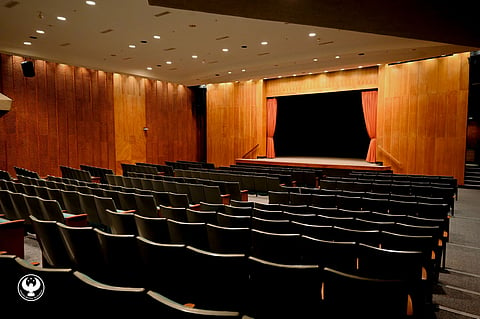
- NEWS
- the EDIT
- COMMENTARY
- BUSINESS
- LIFE
- SHOW
- ACTION
- GLOBAL GOALS
- SNAPS
- DYARYO TIRADA
- MORE

Mention the acronym “PICC” and a wave of memories instantly comes to mind.
For some, it is crossing the grand lobby in their togas with their hearts racing before taking the stage at graduation in the renowned Plenary Hall. Others enjoy the subdued elegance of a wedding held in the Reception Hall, or a week-long business gathering held in the Delegation Building. Many Filipinos are also accustomed to seeing it on television, as it serves as a commanding background whenever world leaders visit the Philippines.
Since its opening on 5 September 1976, the Philippine International Convention Center (PICC) has become a prominent landmark in the country’s collective memory.
Built in Pasay City, PICC was designed by National Artist for Architecture Leandro V. Locsin, whose mastery of brutalism produced a masterwork that still inspires wonder almost 50 years later.
The reopening was graced by President Ferdinand R. Marcos Jr. and First Lady Liza Araneta Marcos, with BSP Governor and PICC Chairman Eli M. Remolona Jr. leading the ceremonies.
The President captured the essence of what PICC stands for in his speech, “Every act of creation — no matter how small — is an act of courage. It is an act of hope,” President Marcos said.
“If the PICC has shown us anything, it is this: That creativity, when nurtured, endures. That artistry, when given space, inspires. And that every Filipino, no matter who or where they are, can bring light, meaning and beauty to the world.”
Brutalism with soul
At first glance, the PICC appears to be an homage to raw power, with large exposed concrete slabs, imposing geometric forms and cavernous interiors. Brutalism, which frequently gets twisted as cold or severe, is elevated here to the level of poetry. The rough concrete, left unpainted to reveal its natural material, contrasts with gleaming red narra wood panels, thousands of flashing droplights, and sculptural chandeliers.
Inside, it appears like Locsin carved up a refuge in which Filipino workmanship and modernist ideals may coexist.
As PICC General Manager Nicolette Ann Cruz explained during the reopening: “Much has been written and said about the PICC and its architecture and construction through the years. In its simplest sense, the PICC is a convention center, a physical point of domestic and global convergence. This is a place of discussion and debate, a platform of commemoration and celebration. Metaphysically, though, the PICC is not just heritage infrastructure. Nothing unites more than the PICC.”
For Cruz, the recent renovation was not just about concrete and chandeliers. “This is not simply and exclusively a restoration of a physical infrastructure, or of a heritage facility, or even of a National Cultural Treasure. This is a restoration of the faith and hope of the Filipino people in the government’s determination and motivation to serve, in public infrastructure that unites and in beautiful legacies that endure.”
A legacy reborn
The PICC has reopened after considerable renovation, over 50 years after its completion.
The reconstruction was overseen by the Bangko Sentral ng Pilipinas (BSP), which sought to preserve Locsin’s brutalist vision while updating its amenities.
The rebuilt front lawn emphasizes the floating structure of the Delegation Building, while the 3,068 shining droplights, metallic-painted ceiling and polished marble floors of the Delegation Lobby add to its revived grandeur. The Delegation Lounge was updated for world leaders with new furniture, finishes and discreet VVIP (very, very important person) security, while upper-level conference spaces and offices were rebuilt to complement the building’s architecture in a more modern style.
Meanwhile, the Secretariat Building greets visitors with a brighter lobby, new stairs, refurbished meeting rooms and banquet halls that combine traditional elements with modern capacities.
The Plenary Hall boasts of refinished woodwork and brass-numbered chairs, as well as cutting-edge audio, lighting and light-emitting (LED) screens, while the Reception Hall exudes elegance with restored chandeliers, ceilings and fabric walls. Arturo Luz’s distinctive Grid sculpture and lobby elements are now accentuated by enhanced lighting, while the Courtyard has been transformed into an open-air gallery.
At the hall’s heart is Luz’s Anito sculpture, which is framed by relocated APEC pieces, while flooring was revitalized with pebbles. Refurbishments also include rich vegetation and a new infinity cascade, giving the venue a timeless yet updated feel.
Walking through the renovated complex feels like stepping into a living museum with masterpieces such as the “Pagdiriwang” mural by National Artist Jose Joya, Arturo Luz’s steel sculpture “Grid” and the courtyard’s centerpiece sculpture “Anito.”
A national symbol
The PICC is a stage where the Philippines has welcomed the world and where Filipinos have celebrated milestones both grand and intimate. It is a site where architecture becomes memory and memory becomes nationhood.
As it approaches its golden anniversary, the PICC is preparing to host yet another historic event: the Association of Southeast Asian Nations (ASEAN) Summit in 2026. Recently honored with the first Tourism Excellence Award for MICE Venue at the Philippine Tourism Awards, it reaffirms its place as a trailblazer in the industry.
Locsin’s brutalism remains intact, but within it breathes warmth, artistry and the Filipino spirit.
The PICC’s beauty is not fragile nor ornamental; it is brutally beautiful, a monument of concrete and courage that endures because it is rooted in the faith, pride and creativity of the people it represents.
In the words of Cruz, “We did this for our country, as we should. As we should.”
